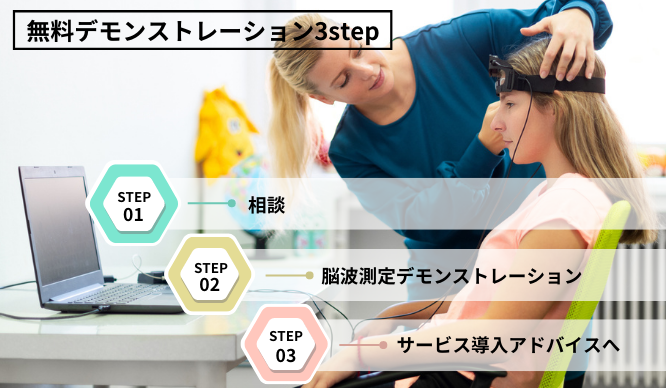Application for evaluation machine
Does gambling affect your brain waves? Introduction about FRN!
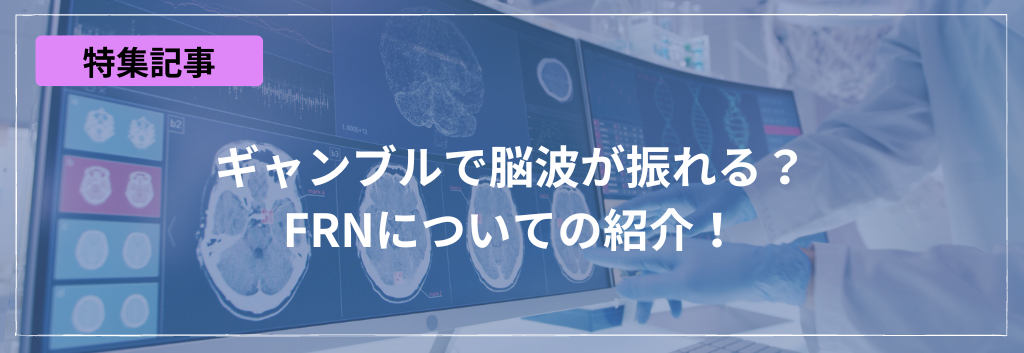
gambling and brain waves
In the world of brain waves and neuroscience, we use brain waves to measure and analyze human brain activity without putting it into words, such as measuring brain waves for cognition and measuring concentration and interest level from brain waves.
Its usage has expanded in recent years.
Therefore, this time we will introduce the brain wave "FRN", which is said to be responsive to gambling, along with the contents of brain wave measurements conducted at our company.
ERP P300 and FRN
"ERP (Event-related potential)" is a brain response that occurs as a result of human cognition in response to internal and external stimuli.
For example, * P300, an event-related potential, is widely recognized in the world of neuroscience, as it has been observed that brain waves rise 300 milliseconds after recognition of a target event in response to various events. .
Reference: What is event-related potential? https://bsd.neuroinf.jp/wiki/%E4%BA%8B%E8%B1%A1%E9%96%A2%E9%80%A3%E9%9B%BB%E4%BD%8D
Reference: What is P300?
Sutton, S., Braren, M., Zubin, J., & John, E. R. (1965).
Evoked-potential correlates of stimulus uncertainty. Science (New York, NY), 150(3700), 1187-8. [PubMed:5852977] [WorldCat] [DOI]
FRN (Feedback-related negativity), a type of ERP that we will introduce here, is the brain's response to negative outcomes or events that cause negative emotions in situations where positive outcomes are expected. .
Gambling is widely cited as a situation in which FRN 's ``negative emotions'' occur.
Previous research has shown that the FRN responds to monetary rewards and losses, with negative brain wave oscillations typically increasing in response to unfavorable outcomes. In other words, when gambling for returns, FRN is said to occur as a human brain reaction when a return is lower than expected or a loss occurs.
FRN measurement using gambling games
First, we measured FRN using a gambling game.
The game is simple: select one of two cards, and if the selected card has a reward, points will be added, and if the selected card does not have a reward, points will be subtracted.
EEG measurements were conducted on several subjects under the condition that if they repeatedly selected a card and reached a certain number of points, they would actually receive a gift card.
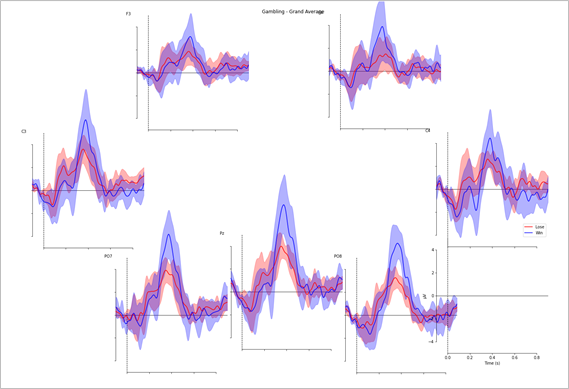
The brain waves shown on the right were measured from this gambling game.
These seven graphs are the average of the brain waves obtained from each electrode used for brain wave measurement.The blue line is the brain waves when a card with a reward is selected, and the red line is the brain wave when a card without a reward is selected. It shows the brain waves of
From these results, a strong response to the presence of reward was seen around 400 milliseconds in PO7, Pz, and PO8, which are mainly located in the back of the head (bottom side in the above diagram).
This suggests a different perspective from the so-called FRN, which swings negatively, but if you compare the blue line and the red line, you can see the difference in brain waves with and without rewards.
FRN measurement by image evaluation
Next, we conducted FRN measurement using image evaluation.
For image evaluation, we prepared a high-quality original image with two levels of contrast deterioration, and asked the subjects to guess whether pressing one of two buttons would display an image with good contrast. We played a game where we had to press one button. As a hypothesis, we inferred that the FRN would fluctuate more when an image with two levels of contrast worsened than an image with one level of contrast worsened.
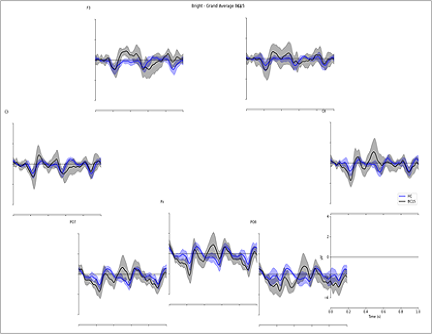
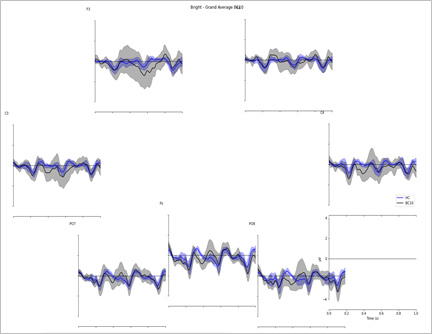
The two figures above are the results of brain wave measurement based on image evaluation. In both cases, as in Figure 1, the seven graphs show the average of the brain waves obtained from each electrode used for EEG measurement, the blue line shows the brain waves when the high-quality original image is displayed, and the gray line shows the brain waves when the high-quality original image is displayed. The lines are brain waves in response to low-quality images; Figure 2 shows the response to an image with two levels of poor quality, and Figure 3 shows the response to an image with one level of poor quality.
From this evaluation, it can be seen that in both Figures 2 and 3, the brain waves for low-quality images sway more negatively than for high-quality images from 200 to 300 milliseconds in the Pz, which corresponds to the back of the head. As mentioned above, this is a brain reaction caused by negative emotions caused by seeing a low-quality image, despite the expectation of a high-quality image.
In addition, Figure 2 shows that the ERP P300 swings more positively than in Figure 3 for low-quality images. This is because the low-quality image compared in Figure 2 clearly has worse contrast than the one in Figure 3, so humans' perception of the low-quality image was clear.
Through this image evaluation, we were able to verify that FRN reactions due to negative emotional reactions occur even when there is no ``financial reward or loss,'' which has been recognized in previous research.
Summary
This time we introduced FRN. Our simple gambling game also clarified that FRN occurs in emotional reactions caused by financial losses, which has been recognized in previous studies. In addition, our own image evaluation has shown that even if there is no monetary loss, FRN can also occur due to negative emotions caused by displaying a low-quality image contrary to expectations for a high-quality image. I hope you understand.
For example, it is possible to utilize this brain activity by measuring the emotional response to a product by measuring the FRN when evaluating when people expect product functionality or quality improvements. It's possible.
In this way, by measuring emotional responses and cognitive brain responses, it will be possible in the not-too-distant future to be able to measure people's evaluations of products and other targets without using language. It is hoped that FRN, which has been recognized as a reaction to gambling in previous research, will be utilized as a material for improving product quality.
free demonstration
Guidance of the demonstration
Would you like to actually measure brain waves?
What is the "skill transfer of experts" based on brain waves? What is AI that learns human consciousness and judgment?
I think there are a lot of unknown things, so why not try measuring your brain waves first and experience what it's like?
After the actual measurement, we will provide support from proposals to implementation and operation so that we can use AI using EEG at the customer's site while including examples of AI utilization in our activities so far. increase.
Click here for details
Click here for related articles
List of articles
If you are interested in other Braintech-related articles, please click here.
Document download

If you want to know the details, please download the materials from here.
Inquiry
If you have any questions regarding this article, please contact us below.



